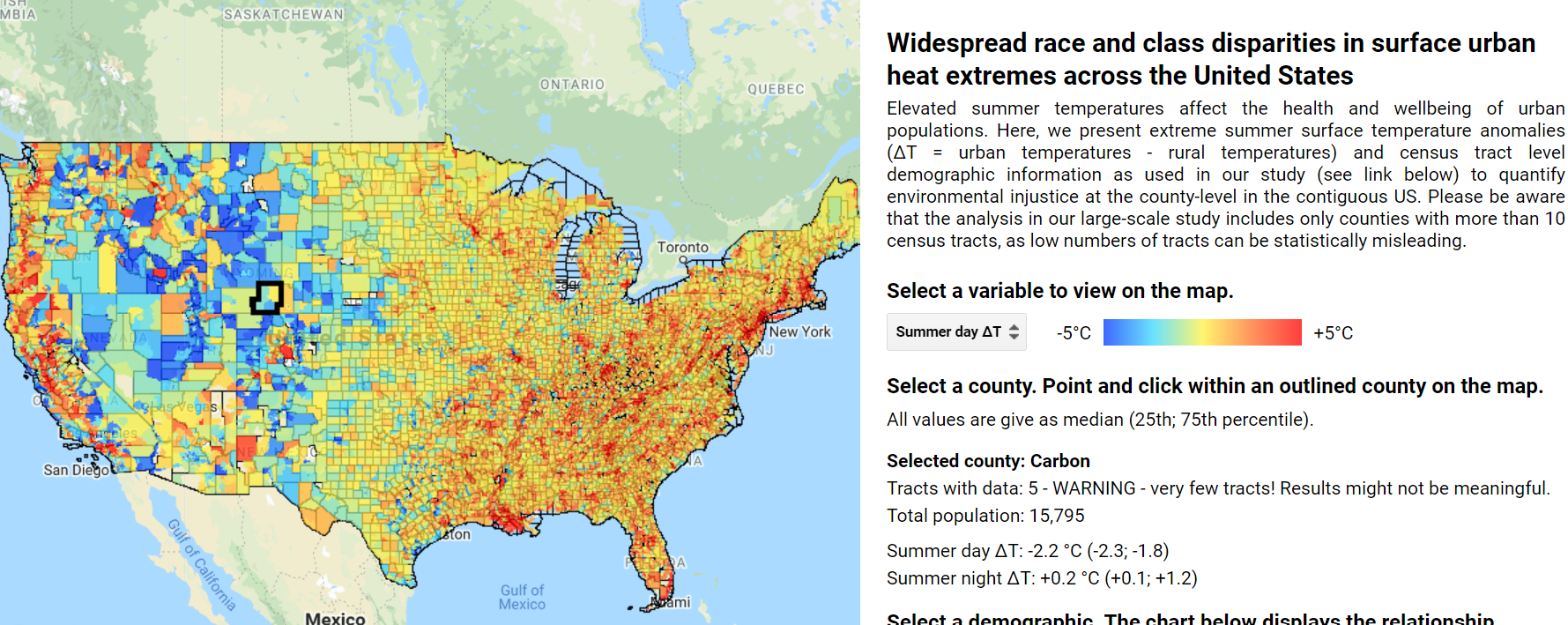In cities and towns across the United States, neighborhoods with more Black, Hispanic and Asian residents experience hotter temperatures during summer heatwaves than nearby white residents, a new study finds. It is the first to show that the trend, documented in some major cities, is widespread, even in small towns, nationwide.
According to the new nationwide study, these racial disparities exist because non-white neighborhoods tend to be more densely built up with buildings and pavement that trap heat and have fewer trees to cool the landscape.
“Urban climate is different from temperatures outside the city,” said co-author Susanne Benz, an environmental scientist who conducted this research at the University of California, San Diego, and is now at Dalhousie University. “Inside the city, temperatures are affected by the buildings surrounding you and by the surface of the streets.” Dark pavement absorbs sunlight and releases the heat at night, while trees and other vegetation cool an area through transpiration, when they release water vapor through pores in the leaves.
The new study is published in Earth’s Future, AGU’s journal for interdisciplinary research on the past, present and future of our planet and its inhabitants. The approach offers city planners and policymakers a way to identify disparities and to evaluate initiatives to address urban heat.
Summer in the city
Summer heatwaves cause more than 700 deaths each year in the United States. When heat and humidity are so high that a body can no longer cool itself through sweating, heat stroke can set in, rapidly causing brain and organ damage. People who are older, have certain chronic health conditions or are physically exerting themselves are most at risk. Urban environments are commonly hotter than their rural counterparts, and temperatures can vary even within cities. Those few degrees can mean life or death for some residents.
Benz initially had the idea for this study after reading a New York Times article finding that neighborhoods the U.S. government redlined in the 1930s–meaning they classified them as poor investments because people of color lived there–are now hotter than white neighborhoods in the same cities. She and co-author Jennifer Burney, an Earth scientist at the University of California, San Diego, realized they could do a similar analysis for the entire country.
Benz looked for urban heat patterns using land surface temperatures during summer heat waves collected by a NASA satellite. She subtracted the temperature of nearby rural locations to find variations in urban heat across towns and cities. Then she combined the temperature data with demographic information from the U.S. Census, looking at more than 1,000 counties to see who was most impacted. NOAA and USGS survey data allowed her to estimate how densely built up an area was, and the proportion of land covered by trees.

The researchers found that in 76% of counties with more than 10 census tracts, poorer neighborhoods were notably hotter than wealthier ones, primarily due to physical differences–more pavement and people and fewer trees. Areas with a larger percentage of people of color or where people had less education also experienced higher temperatures.
Big cities weren’t the only places with race-related heat differences. Benz and Burney also saw the same patterns playing out in less developed areas. “It turns out that even your tiny towns have the same disparities,” Benz said, “and this was something that really shocked me.”
The trend held up even when they took wealth out of the picture. When residents had a similar income, non-white neighborhoods still faced significantly higher temperatures than white ones in 71% of the counties.
“The findings are really quite staggering,” said Jeremy Hoffman, a climate scientist and chief scientist at the Science Museum of Virginia, who was not involved in the research. “These disparities exist across virtually every built environment in the country. Money doesn’t grow on trees, but it is certainly concentrated underneath them across the U.S.”
How to beat urban heat
The new analysis provides information for policymakers and establishes a way to evaluate the success of policies designed to address urban heat. “There’s a lot of talk in Biden’s administration about environmental justice but not so much clarity on what metrics might be used to evaluate policy proposals,” said Burney. “These are very concrete metrics that can be tracked over time.”
Now that officials can recognize and measure urban heat disparities, the big question is how to fix them.
Hoffman thinks it will take thoughtful investment to cool off hotter neighborhoods, such as planting trees at parks, bus stops and along pedestrian thoroughfares and providing incentives for green or white reflective roofs to cool buildings. These initiatives could dovetail with urban agriculture programs, solar panel installation, workforce development and other programs to more holistically address racial inequality.
Benz hopes that this analysis will be useful for all communities, but especially for smaller towns, whose residents can use the information to understand where disparities exist and take steps to correct them–before they become entrenched through further urbanization. She created a website where interested users can visualize where heat extremes exist in their area.



Leave a Reply